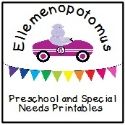One of the concepts we went over fairly recently is regrouping numbers. In Right Start, they call this the "9's trick". For instance, if you have 9+5, you can take one from the 5, give it to the 9, and then you have a much more workable problem: 10+4. Since the whole concept of Right Start is to get the child thinking in terms of 10's and 5's, a problem like 10+4 is much easier to a child raised on RS, than a problem like 9+5 is.
As a child, I would work out my math problems like this--9+5 is...10, 11, 12, 13, 14. 9+5 is 14. Yes, I know, that's nuts, isn't it? I was never taught another way. But the 9's trick, is just that--a better way to think about math.
Right start also teaches the child to do this for problems involving 8 (taking 2 from one number and giving it to the 8, so 8+4 becomes 10+2).
One of the manipulatives that the Right Start program relies on is the AL abacus. It differs from a regular abacus in that it has 5 blue beads on the left and then 5 yellow beads on the right. This allows the student to not only see groups of ten (there are ten beads on each bar), but also smaller groups of 5 as well. Right Start uses the abacus to teach regrouping, or completing the 10 in this way:
Say the problem is 9+6. The child enters 9 on the first wire and 6 on the second wire. Then the child takes one bead from the 6 wire and gives it to the 9 wire, thus changing the problem from 9+6 to 10+5.
You can see how they are doing it again, using larger numbers. They also teach the child how to use the back side of the abacus to work these problems. I look at the back side of the abacus almost like a place value chart. Beads are entered in pairs of twos (unless the number is odd of course). There are two wires for each place (1's, 10's, 100's, and 1000's). Thus the child can work problems well into the thousands using concrete materials. Little Bean really caught on to this concept, so he did not need to use the physical abacus at all for the 9's trick. As he puts it, he "uses the abacus in his brain," and "moves the beads with his eyes". :)
Little Bean still has not learned paper and pencil addition (except for single digit addition). He doesn't carry or borrow. But, he does add double and even triple digits mentally. What's 39+5? Little Bean can tell you. What's 9+54? Little Bean can tell you. What's 129+8? Little Bean can tell you. And all without picking up a pencil!
Tell me again why I love Right Start?? Oh, wait, I already know! ;)
























2 comments:
We use RSM too. We definitely do not get through 5 lessons in a week! My almost 6 year old doesn't have the attention span for a complete lesson every day. Maybe it's because she's not quite old enough. We're also working on Level B but just now getting to learning 100s and 1000s. I haven't heard from many others about RSM so thanks for sharing this post.
We LOVE RightStart also! I am almost done with Level A with my 5 year old (I think we maybe have about 15 lessons left) and it amazes me that she can easily add all of her single digits that equal 10 or less without even thinking about it now. She is adding single digits with the 10's (10,20,30,etc) easily as well.
Being kind of a math geek (it was always my favorite subject) I really, really like the way this curriculum is taught. I think using the abacus and teaching with 5's and 10's is genius. I love that it's not having them just simply memorize the math facts, that it's teaching them how to compute large problems in their head.
I can't wait to get started on Level B with her. This is such a great curriculum. I always recommend it to anyone asking about math curriculum. Love it! (Can you tell I love it? ;)
Post a Comment